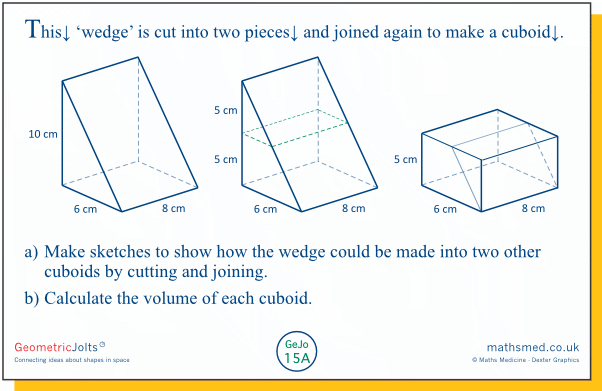Describe translations as 2D transformations.
Apply addition and subtraction of vectors, multiplication of vectors by scalar, and diagrammatic and column representations of vectors; {use vectors to construct geometric arguments and proofs}.
Here we have collected together the final two Key Stage 4 geometry statements of 'knowledge, skills and understanding', which we address in this final week's set of tasks.
Vectors are powerful in that they allow us to apply abstract algebraic processes to geometry and thereby also expand geometric ideas. However, it is difficult to convey their power at this level of mathematics. Indeed, at this level they can often seem cumbersome and obscure when used to prove statements that already seem obvious or are amenable to more familiar and tangible geometric processes. [But see Wednesday's task, where the use of vectors provides quite an efficient way of comparing magnitudes.]
MONDAY: This task might seem rather abstract at first, but a careful examination of the diagram should help ground the task.
9m + 2n = 19 and m + 5n = 26.
However, we can also solve the task by inspection. Given that m and n are whole numbers, the value of n must be 1. For example, a value of 2 would give us an x-component of at least 2×9+2 which takes us too far to the right. In turn, the value of n must be 5, to give us an x-component of 19 = 1×9 + 5×2.
TUESDAY: The aim here is to spot a relation and to express it in general form. Beyond that, students might feel it has little purpose!
Students should find the first part to be quite straightforward. If they reflect upon it, they might discern that the vector for point B has an x-component that is 18 – 10 more than that for A and a y-component that is 77 – 50 less. So the vector that maps B onto Q can be written as this:
WEDNESDAY: This task provides quite a nice mixture of the visualising activities that one associates with Euclidean geometry and the numerical/analytic approach associated with vectors.
There are simple relationships, which we can discern from the geometry of the regular octagon, between the x- and y-components of the vectors AC, CE and HF, whilst AE is the sum of AC and CE. The desired vectors are these (written as rows for typographical reasons!):
CE = (-1 1+√2), AE = (√2 2+√2), HF = (1 1+√2).
We already know, from the symmetry of the regular octagon, that AE is parallel to HF. The vectors confirm this, since √2×HF = (√2×1 √2×1+√2×√2) = (√2 2+√2) = AE. This also shows that AE = √2×HF. We could, of course, have determined this from what we know about the relation between the lengths of the side and diagonal of a square (see the diagram below). But interestingly here, deriving this relation using vectors is more efficient than doing so by calculating the actual lengths of AE and HF (using Pythagoras' Rule and our knowledge about the dimensions of the regular octagon).
THURSDAY: This task involves another regular polygon - the dodecagon.
The size of the exterior angles of a regular dodecagon is 30˚. This means that the magnitude of vector b is twice the magnitude of its y-component, so the magnitude is 2√3 units. [Alternatively, we could use Pythagoras' Rule: (magnitude)² = 3² + (√3)² = 9 + 3 = 12, so magnitude = √12 = 2√3.] In turn this means vector a (written as a row) = (2√3 0).
We can use the symmetry of the regular dodecagon to relate c to b and thus determine that c = (√3 3).
Vector PS is the sum of vectors a, b and c,
so PS = (2√3+3+√3 0+√3+3) = (3+3√3 3+√3) = [1+√3]×(3 √3) = [1+√3]×b.
And so PS is parallel to b.
FRIDAY: One aim of this task is to illustrate the potential power of a vector-based approach for solving geometric problems and how this may require little more than handle-turning with relatively little thought - and which, in turn, may provide very little insight when compared to a more visual approach!
Students might need some help with understanding what is meant by 'equating the coefficients' and with appreciating the power of doing so. We have tried to make the task more accessible by providing students with the two expressions for the vector AP. However, constructing such expressions is perhaps the most interesting aspect of a vector approach, so you might want to give some students the opportunity to derive the expressions themselves.
The two expressions for AP capture the fact that:
• AP lies on AC, a vector that we know
• we can get from A to P via the point E whose position we know.
Once we equate the coefficients in the two expressions, the values of m and n emerge automatically from the solution process:
We can see that mu = nu, and so m = n.
And we can see that mv = ¼v –¼nv, so m = n = ¼ –¼n, and so ⁵⁄₄ n = ¼, and so n = ⅕ = m.
However, this algebraic approach will carry very little meaning for many of us. Compare it to the geometric approach below, which shows that m = ⅕ (below, left) and n = ⅕ (below, right).
























































